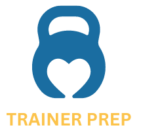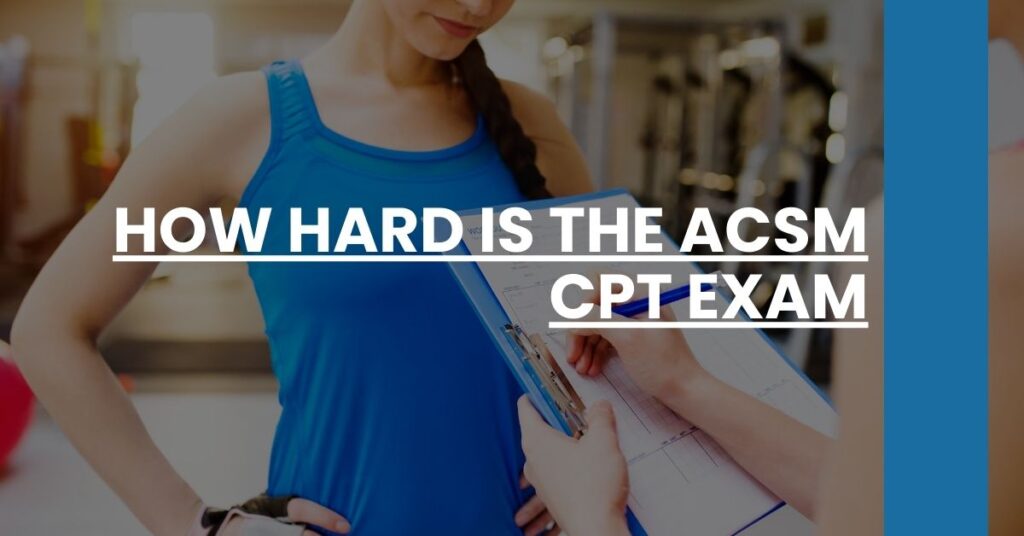The ACSM CPT exam is considered challenging due to its in-depth coverage of exercise science, program design, and client assessments. With a pass rate around 71%, candidates need to score at least 550 out of 800 to pass.
Preparation involves dedicated study using ACSM materials and practice exams. Success requires understanding both theoretical concepts and practical applications in fitness.
In this article, you’ll find:
- Exam content and structure
- Tips and strategies for success
- Preparation resources and recertification details
What is the ACSM CPT Exam?
The ACSM CPT (American College of Sports Medicine Certified Personal Trainer) exam is a prominent certification for fitness professionals aspiring to validate their skills and knowledge. Conducted by the renowned American College of Sports Medicine, this exam certifies trainers to work in various settings, including gyms, health clubs, and private training.
Purpose and Importance
The ACSM CPT exam aims to ensure that personal trainers are proficient in creating safe, effective exercise programs tailored to individual clients. The certification holds significant weight in the fitness industry, enhancing career prospects and demonstrating a commitment to professional excellence.
Eligibility Criteria
To sit for the ACSM CPT exam, you must be at least 18 years old and possess a high school diploma or equivalent. Additionally, you need to have a current adult CPR/AED certification with a practical skills component. These prerequisites ensure that candidates have a foundational understanding and readiness to handle emergencies.
Exam Content and Structure
The ACSM CPT exam assesses a broad range of topics to evaluate your comprehensive expertise as a personal trainer. Understanding the exam’s content and structure can help you better prepare and manage your study schedule effectively.
Exam Domains and Topics
The exam comprises 150 multiple-choice questions that are distributed across four major performance domains:
- Initial Client Consultation and Assessment (25%): This domain covers the procedures and protocols related to initial client interactions, including health screenings, risk assessments, and goal setting.
- Exercise Programming and Implementation (45%): This significant portion focuses on designing, implementing, and modifying exercise programs based on clients’ needs, goals, and abilities.
- Exercise Leadership and Client Education (20%): This section emphasizes the principles of exercise leadership, teaching proper technique, and providing appropriate feedback and motivation to clients.
- Legal and Professional Responsibilities (10%): This domain addresses the legal aspects of personal training, ensuring that trainers uphold industry standards and ethical practices.
Question Types and Time Management
The multiple-choice questions include both scenario-based and knowledge-based queries. You have 165 minutes to complete the exam, which requires efficient time management. Each question demands careful consideration, as they often test your ability to apply theoretical knowledge in practical scenarios.
Difficulty Level of the ACSM CPT Exam
Complexity of Questions
The ACSM CPT exam is known for its challenging questions that test both your theoretical understanding and practical application skills. These questions often involve real-life scenarios, where you need to demonstrate your ability to design and adjust exercise programs, assess client needs, and react to various situations effectively.
Time Constraints
Given the 165-minute time limit for 150 questions, pacing is crucial. The comprehensive nature of the exam means that you need to allocate your time wisely to avoid rushing through the more complex questions. Efficiently managing your exam time ensures you can give each question the consideration it deserves.
Breadth of Topics
The extensive scope of the exam, covering everything from exercise science fundamentals to client interactions and legal responsibilities, adds to its difficulty. You must be well-versed in a wide range of topics, which necessitates a thorough and structured study approach.
Preparation Requirements and Study Materials
Recommended Study Resources
Preparing for the ACSM CPT exam requires a strategic approach and utilization of high-quality study materials. The following resources are highly recommended:
- ACSM’s Resources for the Personal Trainer: This textbook provides a solid foundation, covering all the essential topics in depth.
- ACSM CPT Exam Practice Tests: Utilizing practice tests helps familiarize you with the question format and identify areas where you need further study.
- ACSM Exam Secrets Study Guide: This guide offers test-taking strategies and critical review questions to enhance your preparation.
- Online Exam Prep Courses: Consider enrolling in an exam prep course that offers interactive content, video lectures, and personalized study plans.
Creating a Study Schedule
- Assess Your Starting Point: Begin by taking a practice test to determine your strengths and weaknesses.
- Develop a Schedule: Plan your study time effectively, allocating more time to topics where you are less confident.
- Use Multiple Resources: Diversify your studying with textbooks, online courses, and study guides to cover all aspects thoroughly.
- Regular Revision: Regularly review what you’ve learned to reinforce your knowledge and maintain retention.
Tips for Effective Study
- Set Realistic Goals: Break down your study goals into manageable tasks to avoid feeling overwhelmed.
- Active Learning: Engage actively with the material through note-taking, summarizing, and discussing concepts with peers or mentors.
- Mock Exams: Periodically take full-length mock exams under timed conditions to gauge your progress and improve your test-taking stamina.
Staying Motivated
Maintaining motivation throughout your study period is crucial for success. Here are some strategies that can help:
- Join a Study Group: Collaborating with others can provide support and keep you motivated.
- Track Your Progress: Use a journal or app to track your study hours and progress, celebrating small milestones along the way.
- Visualize Success: Keep your end goal in mind and visualize yourself successfully passing the exam to stay inspired.
To enhance your study experience, consider exploring our services at TrainerPrep for personalized preparation plans and additional resources designed to help you ace the ACSM CPT exam.
Pass Rates and Statistics
Pass Rate Insights
Understanding pass rates can give you a valuable perspective on how challenging the ACSM CPT exam is. On average, the pass rate hovers around 71%, indicating that nearly one-third of test-takers don’t pass on their first attempt. This statistic underscores the necessity for thorough preparation.
What the Pass Rates Indicate
Analyzing these pass rates reveals the exam’s rigor. The ACSM CPT exam tests a wide range of knowledge and skills, demanding more than just rote memorization. The relatively high failure rate suggests that those taking the exam need an in-depth understanding of both theoretical and practical aspects of personal training.
Variations in Pass Rates
Pass rates can vary based on factors such as the study methods used, prior experience in the fitness industry, and the amount of time dedicated to preparation. Candidates who engage in structured study schedules, utilize multiple study resources, and take practice exams tend to perform better.
Tips and Strategies for Success
Develop a Structured Study Plan
Creating a structured study plan is crucial for success. It ensures you cover all necessary topics without feeling overwhelmed.
- Set Clear Goals: Identify the key areas you need to focus on and allocate study time accordingly.
- Diversify Your Resources: Use textbooks, online courses, and practice exams to cover the breadth of the syllabus.
- Regular Revisions: Schedule regular revision sessions to reinforce your knowledge.
Effective Study Techniques
Employing effective study techniques can enhance your retention and understanding of the material.
- Active Learning: Engage with the material by summarizing sections, teaching concepts to a study partner, and answering practice questions.
- Mind Mapping: Create mind maps to visually organize and connect concepts. This technique helps in retaining complex information.
- Regular Assessments: Periodically take practice tests to assess your progress and adjust your study plan as needed.
Manage Your Exam Stress
Managing stress on the day of the exam is vital to ensure you perform at your best.
- Practice Relaxation Techniques: Techniques like deep breathing, meditation, and positive visualization can help you stay calm.
- Get Adequate Rest: Ensure you get a good night’s sleep before the exam day to avoid fatigue and maintain concentration.
- Arrive Early: Plan to arrive at the testing center early to minimize any last-minute stress.
Testimonials and Experiences
Real-Life Experiences
Hearing about the experiences of others who have taken the ACSM CPT exam can provide insights and motivation.
- Jane’s Perspective: “I studied for six months and utilized various resources, including the ACSM Essentials textbook and online courses. Despite the rigorous preparation, I found the scenario-based questions challenging.”
- Mark’s Story: “The breadth of topics was overwhelming at first. I scheduled my study sessions around my work and found online practice exams incredibly beneficial. I passed on my second attempt after refining my strategy.”
Lessons Learned from Test-Takers
You can learn a lot from those who have navigated the exam before you.
- Understand the Expectation: Knowing that the exam requires applied knowledge helps in tailoring your study approach.
- Adapt and Modify: After initial setbacks, adjusting the study plan and focusing on weak areas can lead to success.
- Utilize Community Support: Engaging with study groups and forums can provide valuable tips and moral support.
Recertification and Continuing Education
Importance of Recertification
After you achieve your ACSM CPT certification, recertification ensures that you stay current with industry standards and best practices.
Recertification Process
To recertify, you must earn 45 Continuing Education Credits (CECs) every three years. This ongoing education underscores the commitment to professional development and client safety.
Benefits of Continuing Education
Continuing education offers numerous benefits for personal trainers:
- Stay Updated: Keep abreast of the latest research, techniques, and trends in fitness and health.
- Expand Your Skills: Learn new skills and methodologies that can enhance your training programs.
- Increase Credibility: Continued education improves your credibility and can attract more clients.
For further details on the recertification process and managing your continuing education, be sure to consult the ACSM recertification guidelines.
Conclusion
The ACSM CPT exam is undoubtedly challenging, reflecting the high standards expected of certified personal trainers. With a structured study plan, effective preparation strategies, and a strong focus on practical application, you can increase your chances of success. Stay motivated, utilize the wealth of available resources, and view each step as progress toward achieving your certification.

